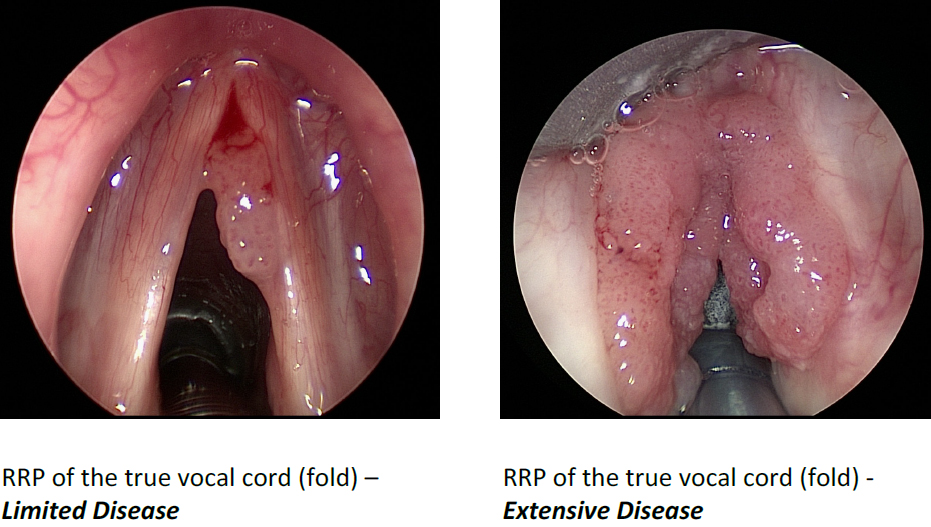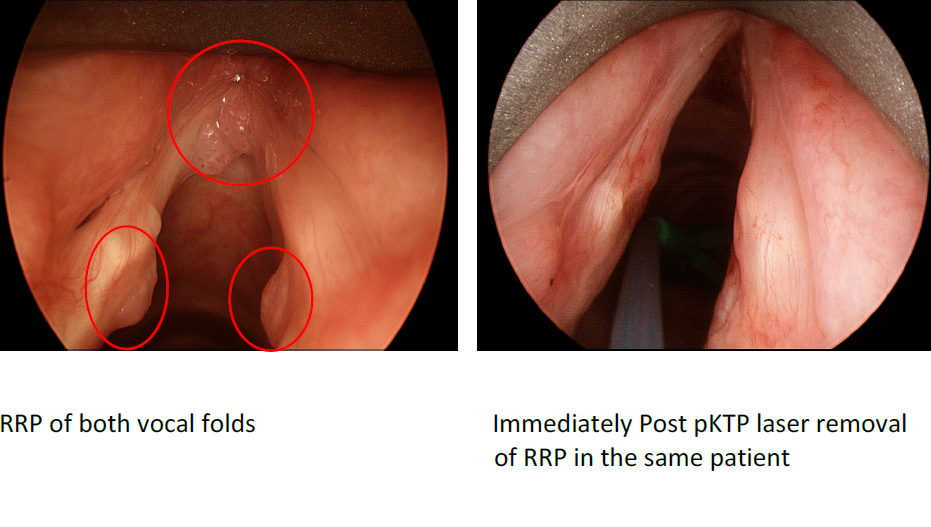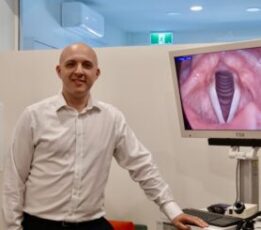Recurrent Respiratory Papillomatosis(RRP)
Definition:
Recurrent Respiratory Papillomatosis (RRP)is characterised by benign (non-cancerous)epithelial growths thattend to effect the vocal cords, but can arise anywhere in the larynx and upper trachea(wind-pipe).Their tendency to recur after surgical removal recur after surgical removal. It affects both children and adults

Causes:
These growths are caused by infection with the Human Papilloma Virus (HPV), of which there are many numbered sub-types. Most commonly subtypes 6 and 11 (there are many different sub-types).
Diagnosis:
On clinical history, in adult patients, hoarseness with a reduced pitch range is the most common symptom but the hoarseness can vary depending on the size and location of the lesion(s).In addition, the sensation of a foreign body at the level of the vocal folds, or a feeling of wanting to clear the throat or coughis common.In children, the morefrequent complaint is difficult or noisy breathing. Other less frequent symptoms include chronic cough, and lower respiratory tract symptoms.
RRPcan be detected via mirror laryngoscopy or video-nasendoscopy under normal light, although they are sometimes mis-diagnosed as other benign vocal cord lesions. RRP osbest diagnosed with stroboscopic light evaluation via oral or nasal endoscopy. This is a sophisticated assessment which gives an idea of the vibratory characteristics of the vocal folds, and allows for greater accuracy in diagnosis of vocal fold lesions. Even then, definitive diagnosis is sometimes only achieved after biopsy.
Management:
Correct diagnosis of vocal fold lesions is the key to receiving appropriate management.There is no cure for RRP, but long-term controland symptom free intervals can be achieved. A key aim, given patients often have numerous surgeries throughout life, is to prevent complications for the treatment itself such as scarring.
If you have been diagnosed with respiratory papillomatosis, then your surgeon will discuss the various medical and surgical treatment options available.Broadly speaking, surgery is the most commonly used treatment for RRP. There are numerous techniques including cold steel, microdebrider, Carbon Dioxide Laser, and pKTP laser.

A number of medical treatments are also available, either to be used as an adjuvantto surgery, or in their own right. Adjuvant medications are applied or injected into the affected areas at the time of surgery. Such drugs have variable evidence of benefit and include Cidofovir, (an injectable anti-viral drug), Bevacizumab (Avastin® - a drug that inhibits the growth of blood vessels in rapidly growing tissues.)
A number of the above techniques such as pKTP laser and Adjuvant injections can also be performed under local anaesthetic using a flexible scope through the nose.
A few oral medications, which need to be taken regularly, and do not replace the need for surgery,have also shown marginal levels of benefit in small studies. These include, Indole-3-Carbinole (I3C – which is derived from cruciferous vegetables such as broccoli, bok-choi, kale, etc,), and Celebrex® (a COX-2 inhibitoranti -inflammatory drug). Treating significant reflux disease where present, has also shown a reduction in the recurrence rate of RRP in a few small studies.
There is much interest in the HPV Vaccines, Gardasil®, and Gardasil9®, which co-incidentally provide immunity to the most common RRP HPV subtypes. Whilst the HPV Vaccinemay be of limited benefit in patients already infected with RRP-causing HPV, early results in Australia,wherethe vaccine has been part of the National Immunisation Program (NIP) since 2007, demonstrate a reduction in the incidence of RRP in children. Research is ongoing.
Please discuss options for management with your Ear, Nose and Throat Specialist and Speech Pathologist.







